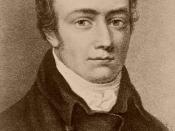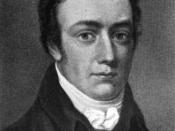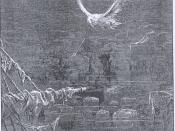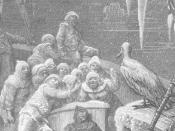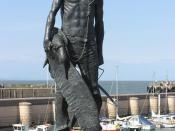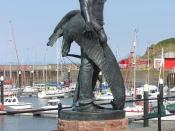Does Coleridge's Quest Fit Campbell's Pattern? When one is looking at the poem "The Rime Of The Ancient Mariner" by Samuel Coleridge in comparison to the Quest Pattern set out by Joseph Campbell many different things can be interpreted. Coleridge's quest in the poem goes hand in hand with Campbell's pattern, although there are some events that happen at different times that are not set out by Campbell but do not interfere with the pattern. Also there are elements that fit into two different events . The quest that the mariner goes through follows Campbell's quest pattern almost exactly.
In "The Rime Of The Ancient Mariner" the mariner's quest starts in the same way as Campbell's quest. The mariner sets sail of his own free will to begin his quest which is what Campbell said, "The hero can go forth of his own free vocation to accomplish delight" (Campbell, Joseph).
Campbell's quest and Coleridge's mariner stay together through the roads of trials, the apotheosis, and the rescue from without. Campbell believes the roads of trials to be "A dream landscape of curiously fluid, ambiguous forms, where he must survive a successions of trials" (Campbell, Joseph). Coleridge has his roads of trials as being without wind and water, "Water, water, everywhere / Nor any drop to drink" (II, 121-122) and "Down dropt the breeze, the sails dropt down"(II, 107).
As well as starting in the same way the poem also ends in the same way with the freedom to live, because the mariner can now be free after he tells his story.
In Campbell's quest pattern he has a supernatural aid, Coleridge also has this aid in his poem. The difference with Campbell's pattern and Coleridge's poem is that in Coleridge's poem the supernatural aid is in many different places and it comes in many different forms such as death's mate, And is that woman all her crew? Is that a death? and are there two? Is death that woman's mate? ( III, 187-189) Mary Queen, "To Mary Queen the praise be given; / She sent the gentle sleep from heaven" (V, 294-295), the Albatross, At length did cross an Albatross, Thorough the fog it came; As if it had been a Christian soul, We hailed it in God's name (I, 63-66) and the dead men.
They groaned, they stirred, they all uprose; Nor spake, nor moved their eyes; it had been strange, even in a dream, To have seen those dead men rise. (V, 331-334) Campbell's pattern does not say anything about only being able to have one supernatural aid so Coleridge's poem still fits the quest pattern.
Coleridge has two different elements that fit into two different events in the quest pattern. In Campbell's quest pattern there is a supernatural aid and the crossing of the first threshold. In Campbell's pattern these are two different elements but in Coleridge's poem the crossing of the threshold is the killing of one of the supernatural aids, which then becomes the threshold guardian. Campbell has a supernatural aid described as "The helpful crone and fairy godmother." (Campbell, Joseph) and while crossing the threshold there is a threshold guardian, this is described by "The hero goes forward in his adventure until he comes to the "threshold guardian" at the entrance to the zone of magnified power" (Campbell, Joseph). The albatross which starts out as a supernatural aid by helping the crew, gets killed and after the albatross is killed the roads of trials begin, And I had done a hellish thing And it would work'em woe: For all averred, I had killed the bird That make the breeze to blow. ( II, 91-94) and that is how the albatross can be a supernatural aid and the threshold guardian.
Another supernatural aid that is also an element in another event is death's mate. She is also in the meeting with the goddess. She fits into the supernatural aid because as Campbell says "The hero who has come under the protection of the cosmic mother cannot be harmed" (Campbell, Joseph) and while she was killing the rest of the mariner's crew she would not let him die " This body dropt not down" (IV, 231). She fits into both because Campbell described the goddess as, "Woman is the guide to the sublime acme of sensuous adventure" (Campbell, James) Coleridge has her relate to that by saying Her lips were red, her looks were free, Her locks were yellow as gold: Her skin was as white as leprosy, The night-mare Life-in-Death was she Who thicks man's blood with cold.
The naked hull alongside came, And the twain were casting dice; The game is done ! I've won, I've won ! Quoth she, and whistles thrice. (III, 190-197) which is when the crew dies and the mariner has to go through the roads of trials and the curse by himself. Therefore, there can be one element in two events.
In conclusion even though there are a few bumps in Coleridge's quest pattern in "The Rime Of The Ancient Mariner" concerning elements that fit into two different events and certain events that have elements jumping around, the poem still fits into the Quest Pattern by Campbell. There are many different ways to pass through a quest and different ways to express it. The basic quest pattern remains the same. Coleridge's quest pattern is the basic quest pattern and that is why it is so easy to relate it to the quest that the mariner goes through in the poem by Samuel Coleridge.
